|
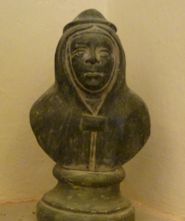 Dwight Peck's personal website Dwight Peck's personal website
Tuscany in the off-season
Arezzo and the neighborhood in February and early March, 2015
You may not find this terribly rewarding unless you're included here, so this is a good time for casual and random browsers to turn back before they get too caught up in the sweep and majesty of the proceedings and can't let go.
Arezzo was at the top of our list when we based ourselves in Lucca a few months ago, but we never made it this far south. So here we are now, based in Arezzo this time, with lots to see roundabout.
South of Arezzo: Castello di Montecchio, Cortona, Lake Trasimeno (I)

A fine morning in Arezzo, 3 March: the Piazza Grande
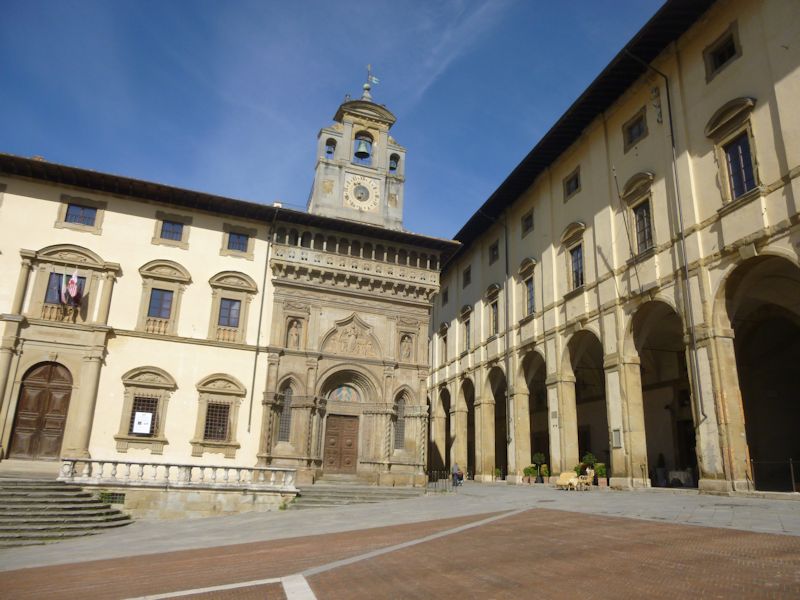
Today we're on our way to Cortona, about 45 minutes to the south on the old state road . . .

. . . but there's always time to peer into antique shop windows. In the Vasari Loggia.

South on state route 71, we've been through Castiglion Fiorentino and just 4km beyond it, that's the Castello di Montecchio Vesponi, overlooking the village of the same name.
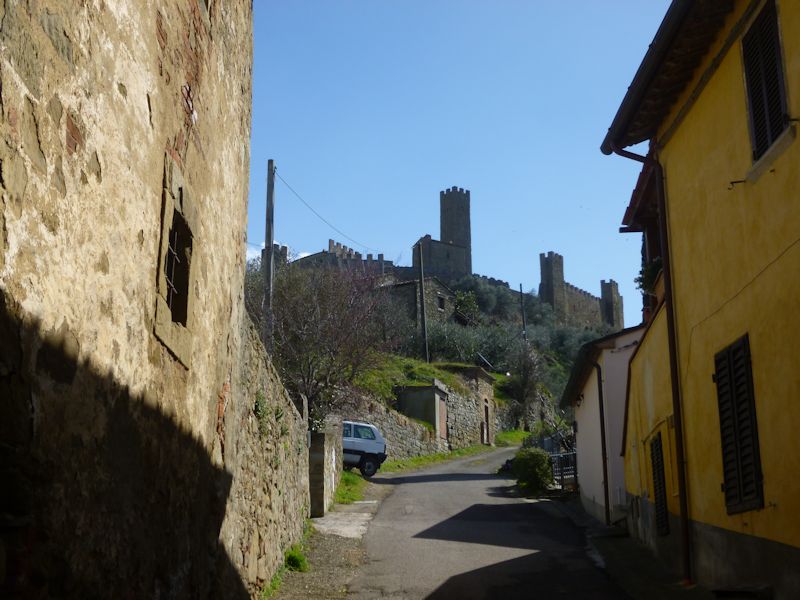
Up the hill above the village, we're at the base of a foot path down from the castle, wondering what we're supposed to do next.
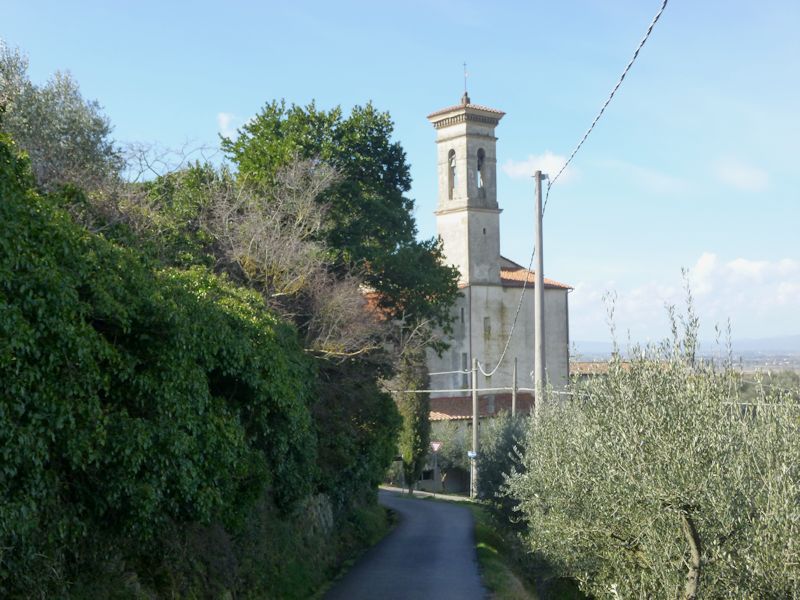
The "signage" is not enlightening, so we've left Sven Volvo near the church and we proceed on foot . . .

. . . for quite a ways.
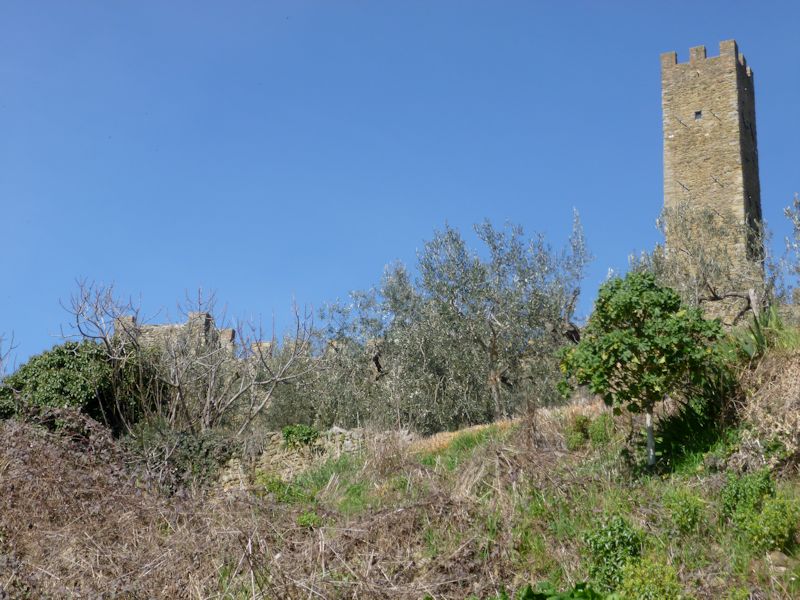
At long last, on a hot day, the castle appears. There was an orginal castle from the 9th century, which in its 12th century incarnation was traded back and forth amongst prominent local families and church institutions (the surname "Vesponi" recalls one of the 11th century families). In about 1234, however, it was purchased by the city of Arezzo, which fixed it up and settled inhabitants within its walls, creating an Aretine balance to the influence of neighboring Cortona and Castiglion Fiorentino.

The gatekeeper's (or groundskeeper's) establishment; we're almost there.

Ooops, nobody home; well, somebody's home, but we're not getting in. Various web sources reveal that the castle either welcomes visitors (but not today), welcomes visitors but only on Saturdays, only hosts groups for special functions, or is closed to the public for a period of "consolidation of the castle walls and excavations".

After Ghibelline Arezzo received a thorough thrashing by Florence's Guelph consortium of Tuscan cities at the Battle of Campaldino in 1289 (near Poppi in the Casentino region of the upper Arno), at which Dante Alighieri helped to fill up the Florentine ranks, Montecchio passed into Florentine hands for a while.
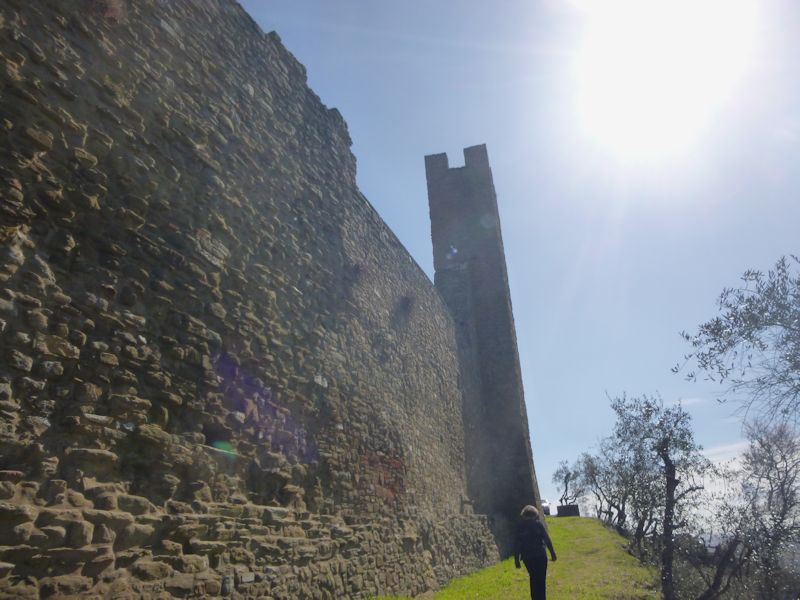
Arezzo regained control of the castle in 1303, and Perugia had it for a while, but by 1384 the famous condottiere Hawkwood and his family had been living here "for some time" and nobody was going to try moving him out of it unless he asked them to.

That's the village of Montecchio Vesponi down the hill, looking out across the flat Val di Chiana, a fertile plain now but a nasty swamp in Hawkwood's time (the word "chiana" was used to describe any nasty, unhealthy place). Leonardo da Vinci developed a project to drain the thing, but it wasn't finally made livable and profitable until the late 18th century.

We're abandoning our quest and starting down the footpath to the village. Sir John Hawkwood, called "Giovanni Acuto" by the Italians whom he served faithfully and terrorized, was one of many English soldiers left stranded in France when the nobles signed the Treaty of Brétigny in 1360, a pause in the Hundred Years' War, and went home. Many of them, realizing that they were well trained and hierarchically organized, set up their own independent military companies and roamed around France, hiring out as mercenary soldiers when they could and plundering and looting in the meantime, which was most of the time.
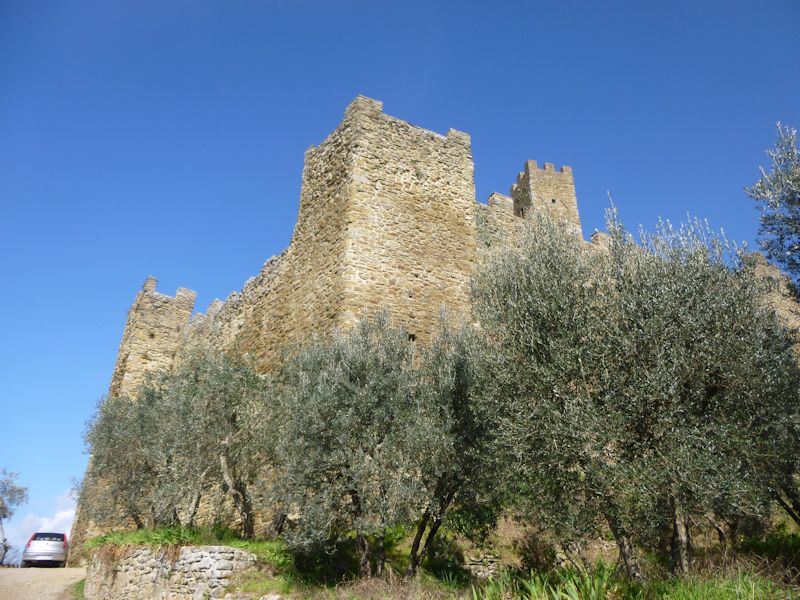
Some of the Companies hired on to assist in the perpetual northern Italian wars, mostly for or against the Visconti Milanese, and set up shop over the Alps. Hawkwood's "White Company" was probably the most successful of these commercial armies, which fitted well into the situation of Italy in the 14th and 15th centuries, where the city states realized 1) that their citizen militias were no match for trained, experienced soldiers and 2) that their small size prevented them from paying trained standing armies of their own.
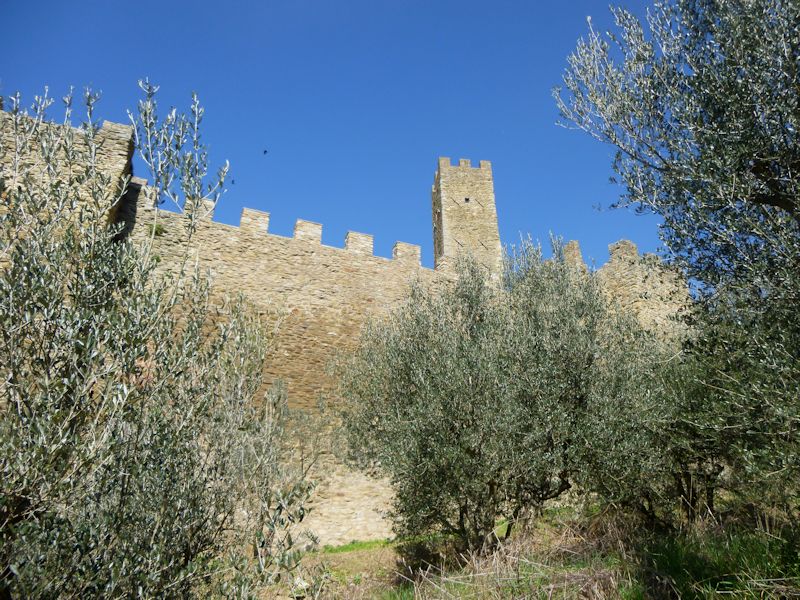
Companies of the condottieri (the "contracters") could be hired when needed and dismissed soon afterward (as long as your enemy didn't outbid you and induce them to change sides; Hawkwood, on principle, didn't like to do that, at least not in the middle of a contract), but when unemployed the Companies had to eat (and loot) and would frequently show up outside a city's walls and request some protection money to pass on down the road.

Hawkwood the Englishman was one of the most interesting of these commanders, and eventually became so necessary to Florence's planning commission (though he'd fought against Florence from time to time) that he was eventually granted citizenship and a pension. At the age of 70 or above, he became commander-in-chief of the Florentine army against the Visconti, and was fêted as the savior of Florence, with a memorial and painting of him by Paolo Uccello in the Duomo (where originally he was buried, until King Richard II requested that his remains be returned to England as a hero of the nation, or something).

Some Internet sources say that Hawkwood bought Montecchio (as a fortified retirement home) or that Florence granted it to him, but according to Stephen Cooper (Sir John Hawkwood: chivalry and the art of war, 2008), he probably just took it and moved in. Arezzo was in no position to disagree with him.

Stephen Cooper's book describes Hawkwood's relationship with Montecchio at great length and provides details about the layout and functions of the castle. Frances Stonor Saunder's book is a bit more substantial about Hawkwood but much less so about this castle (The devil's broker: seeking gold, god, and glory in 14th-century Italy, 2004).
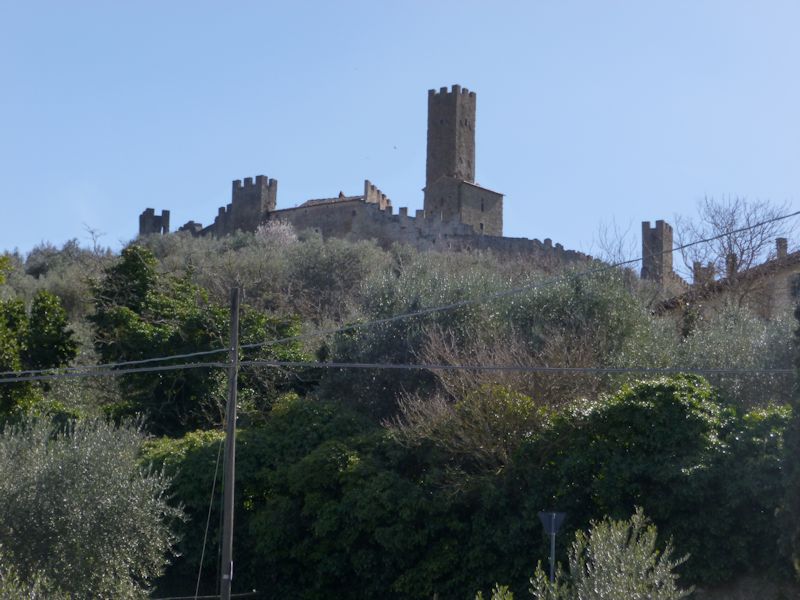
The view from State Route 71 below as we leave town. After Hawkwood's death in 1394, the castle was used by Florentine officials, then sold off into private hands, as with more settled and salubrious times the inhabitants within the walls moved down and set up shop in the newer village on the plain. It fell into ruin over time but has been restored by the present owners.
Cortona

And now we come to Cortona, the shining city on the hill.
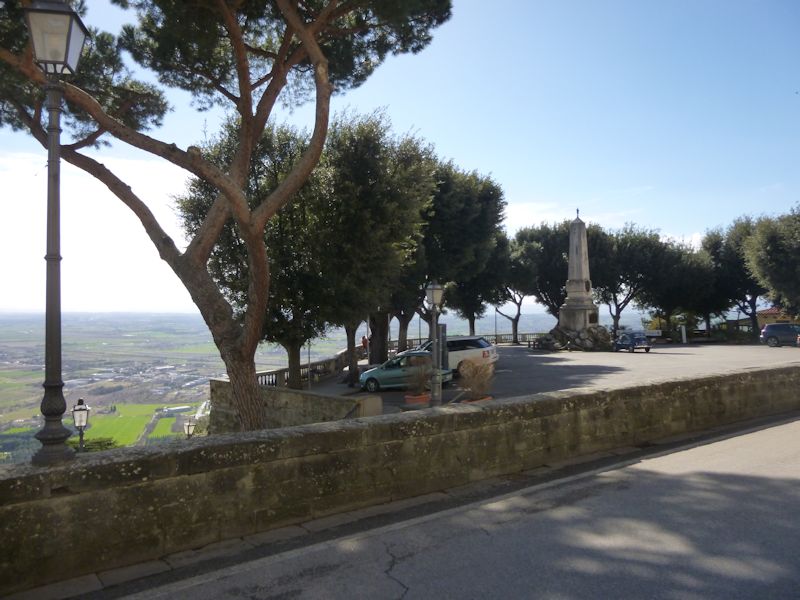
Our entry to Cortona, a small (ca. 23,000 pop.) entirely vertical city on a hilltop overlooking the Valdichiana plain -- we've parked opportunistically below the city walls and trudged up a ways to the Piazza Garibaldi to get our bearings.
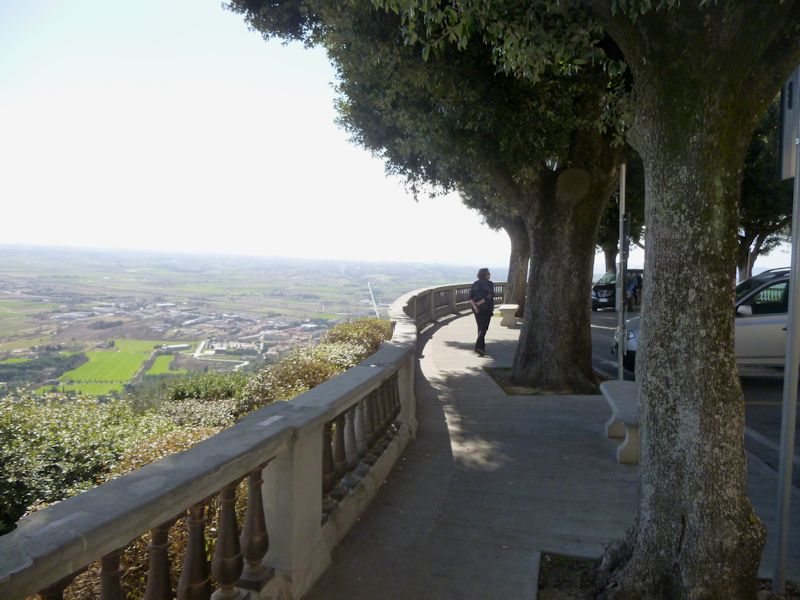
Cortona was originally a hilltop settlement of the Italic Umbrian tribe but was taken over by the Etruscans in the 7th century BC, a member of the twelve-city Etruscan League of that era. In about 310 BC, along with Perugia and other nearby towns, it admitted Roman oversight and, in 90 BC following the Social War, it became a Roman municipium. It suffered badly during the Gothic War of the mid-6th century but carried on bravely during the Lombard years and gained recognition as a Ghibelline-leaning city state in the 13th century.
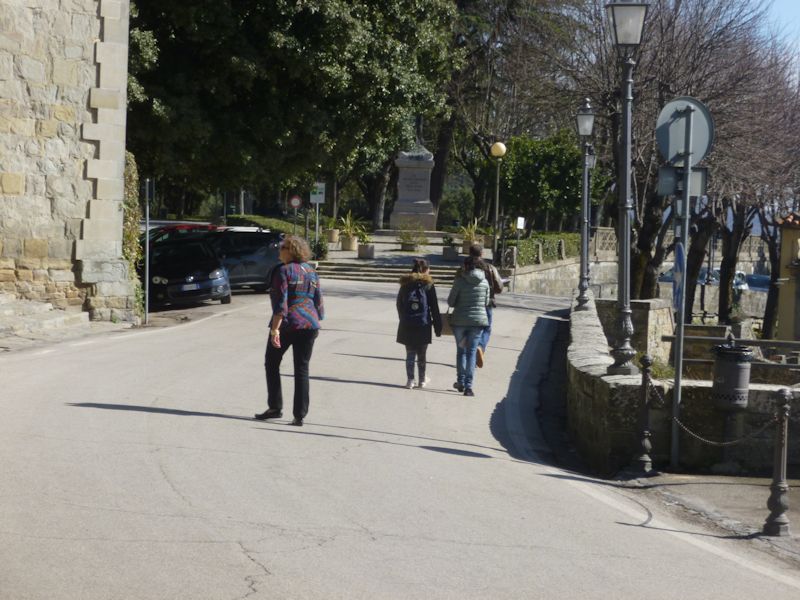
First things first, the Chiesa di San Domenico Cortona
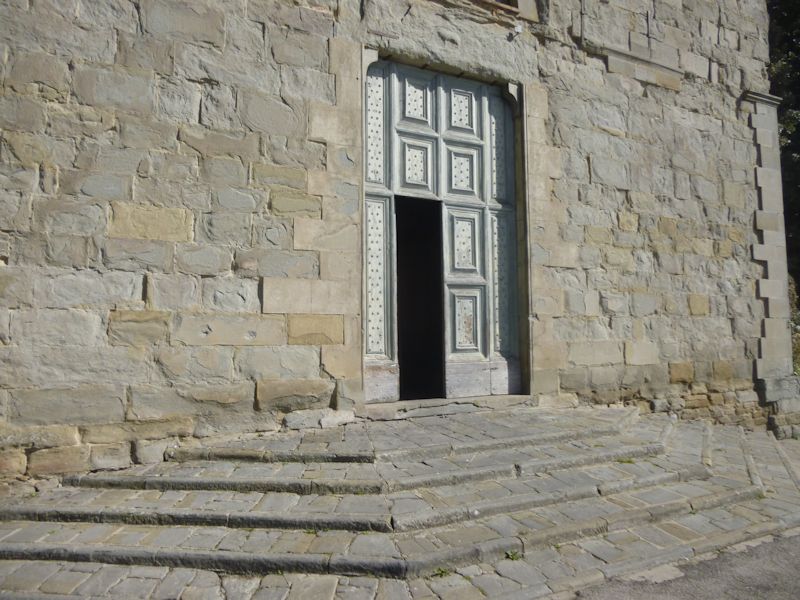
The appropriately understated Dominican church was built in the 14th century and restored in the mid-16th.
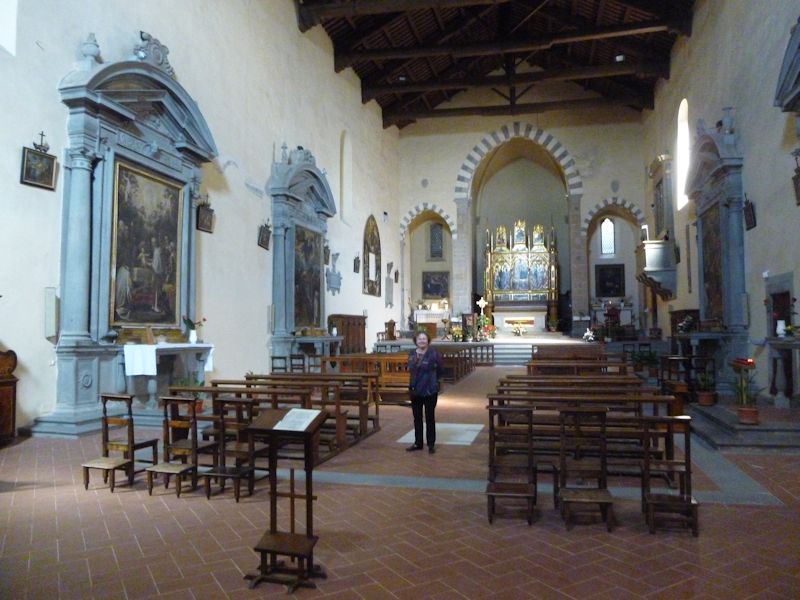
A single nave, sort of cosy

Uneasy lies the head with a 30kg crown on it
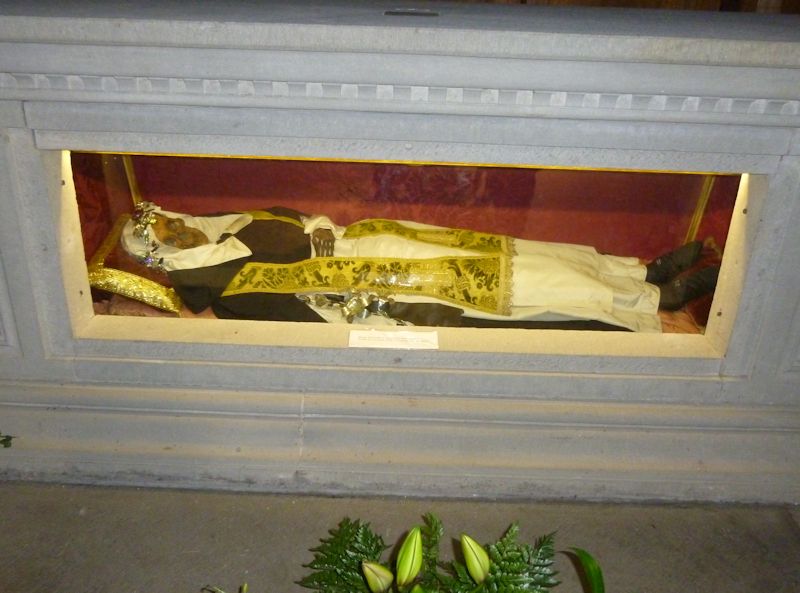
Yikes. That's the Blessed Pietro Capucci, a Dominican who died in Cortona in 1445, but his mother wouldn't recognize him now.
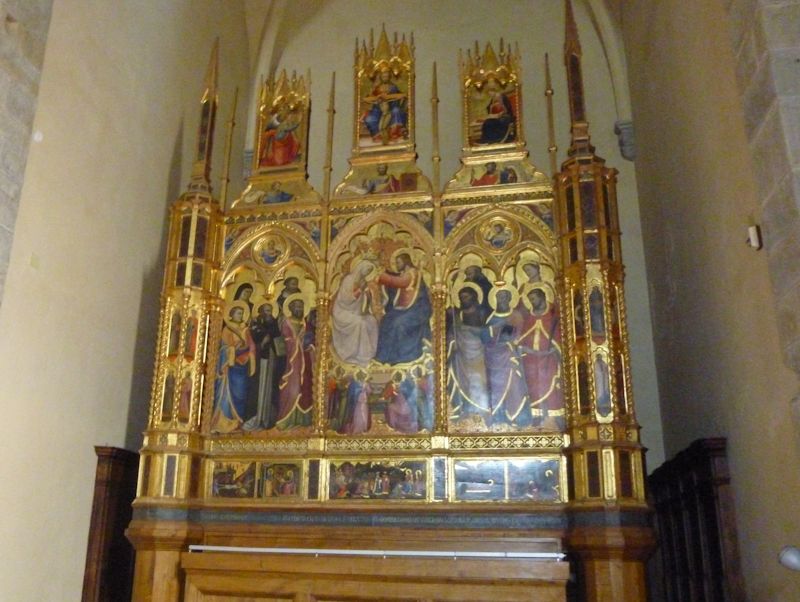
The triptych of the Altar of Our Lady of the Seven Sorrows (early 15th century)
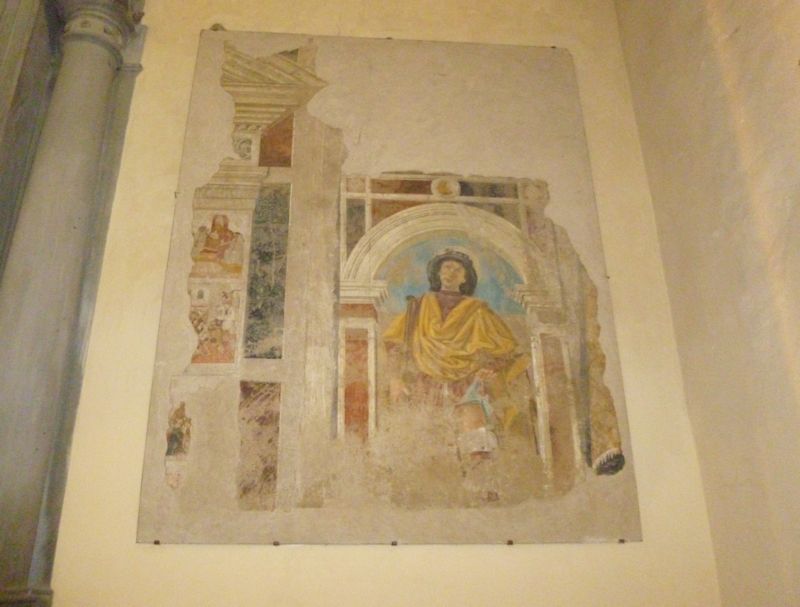
Saint Rocco showing off his buboes again, a fresco discovered here in 1958 and presumed to be by Bartolomeo "della Gatta" (because he loved cats) from the late 15th century
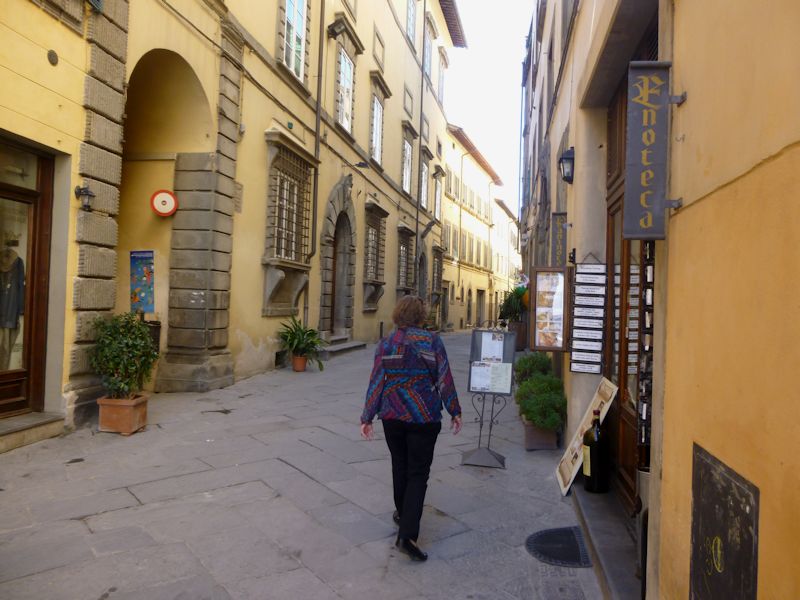
We're processing along from the Piazza Garibaldi down the Via Nazionale, which is the only level street in the entire town . . .

. . . and which is the High Street within the old city walls. For most of the 14th century, Cortona was a wholly owned subsidiary of the local Casali family, but in 1409 it was captured by the Angevin Ladislaus the Magnanimous, King of Naples (and self-described King of Jerusalem, Hungary, and Croatia)(and Count of Provence), who was improving his prospects in central Italy and (with Paolo Guinigi of Lucca) preparing to take on Florence directly for Tuscan supremacy.
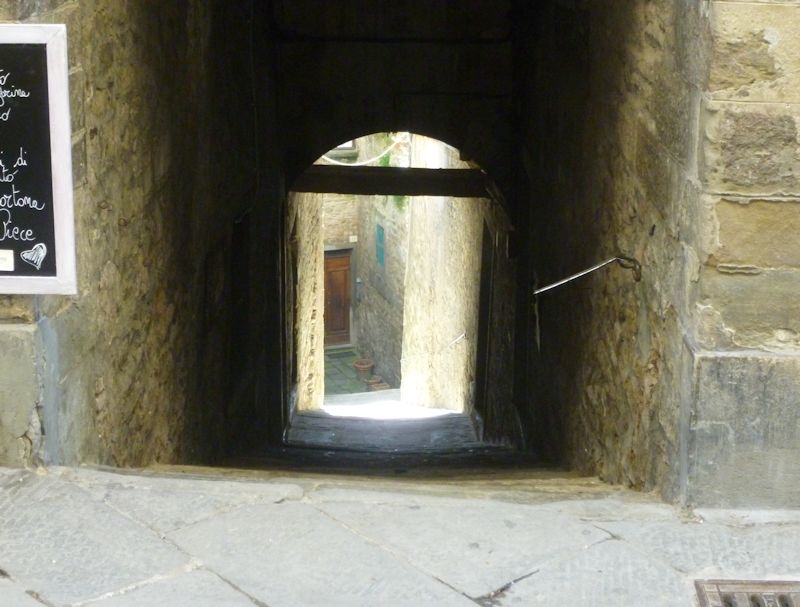
All alleys off the Via Nazionale lead either straight down or . . .

. . . straight up. In 1411 as part of the complicated to and fro between himself and his supporters, like Genoa and Venice, on the one hand and Florence, Siena, the Angevin Louis II of Provence, and the Antipope Alexander V on the other, and their famous mercenary commanders on both sides, King Ladislaus sold Cortona to the Medici family of Florence, whence over time it merged into the Grand Duchy of Tuscany up to the Italian unification.
(The condottieri Braccio da Montone and Muzio Attendolo [founder of the Sforza dynasty] led the Florentine coalition; Carlo I Malatesta was working for Ladislaus, and so was Muzio after a change of mind. At one point, the Antipope John XXIII launched an official Crusade against Ladislaus, with plenary indulgences and all, but in vain.)
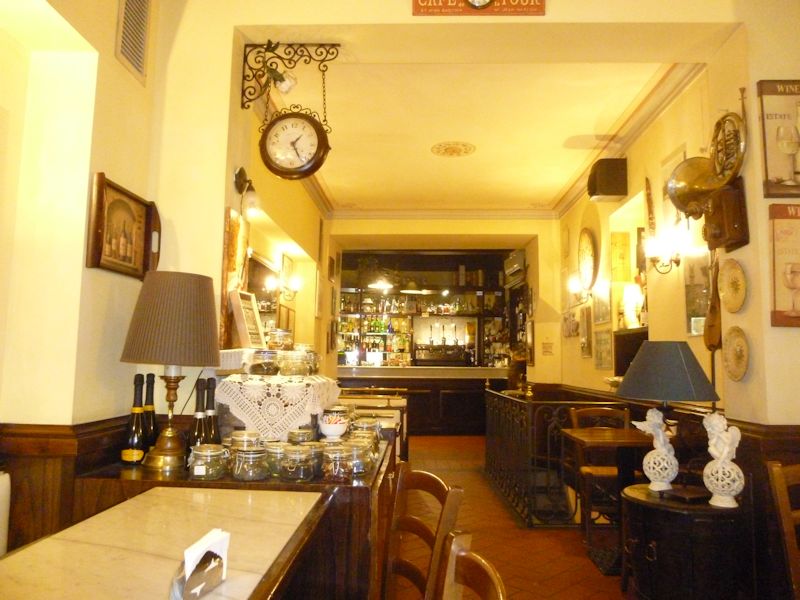
We pause for lunch in the Caffé degli Artisti on the Via Nazionale and consider just staying here forever; absolutely perfect.
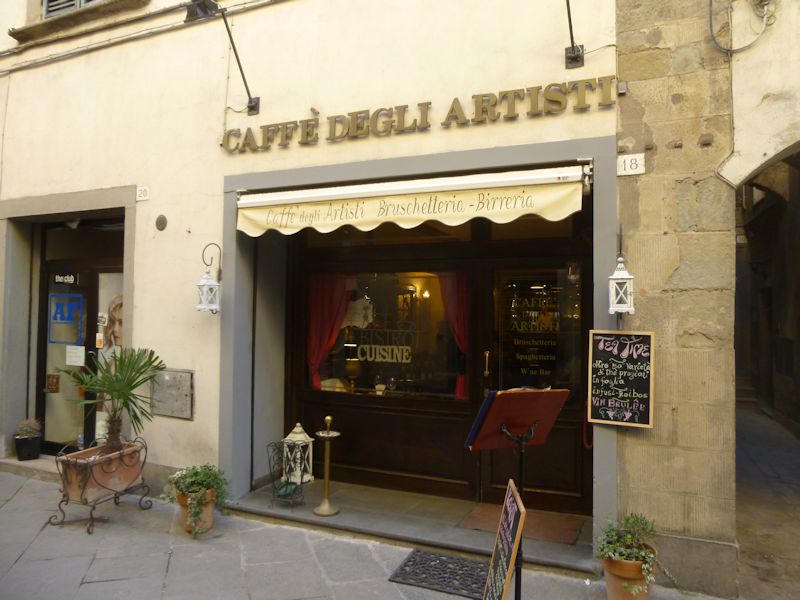
Inexpensive, friendly, and fantastic light pasta, and featuring "Tea Time" with 50 varieties of tea (for fans of tea)

The main town square, the Piazza della Repubblica, and the Palazzo Comunale or city hall, on the site of what had been the Roman Forum at the crossroads of the Roman street grid
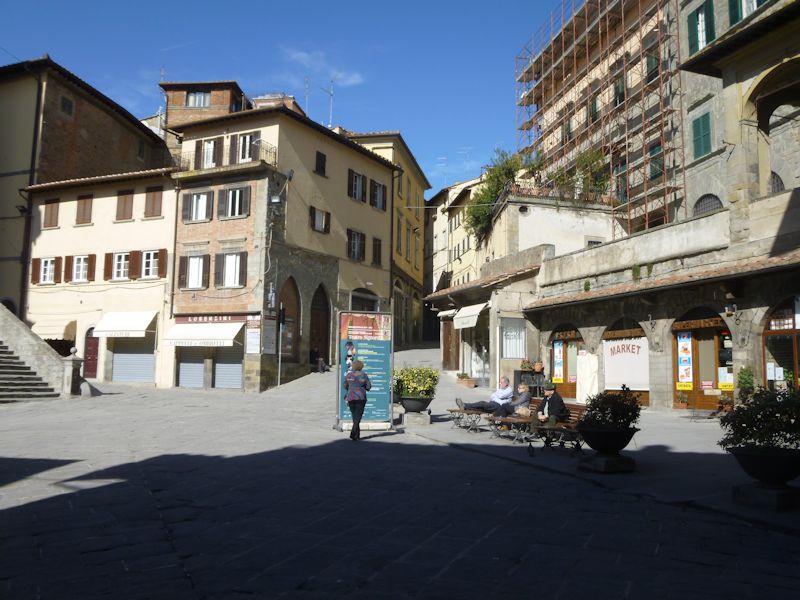
Here's Kristin checking out the opera schedule in the Piazza della Repubblica. Obscured up on the extreme right is the Palazzo del Capitano del Popolo (or Palazzo Passerini), built in the 13th century for the Captain of the People but used for general administration when that office was abolished in 1411, when Florence took over the government here. In 1512 it was donated to a papal overseer, the local Bishop Cardinal Passerini and his heirs, and eventually ended up as a condo.

The main hall of the Palazzo del Consiglio Comunale was built in the early days of commune government in the 12th century, and in the 16th it was extended to the left of the staircase over the arch, under which still passes the Via Roma, the bell tower was built over that, and the staircase was added at that time.

In the Piazza della Repubblica, with the former Palace of the Captain of the People now on the left
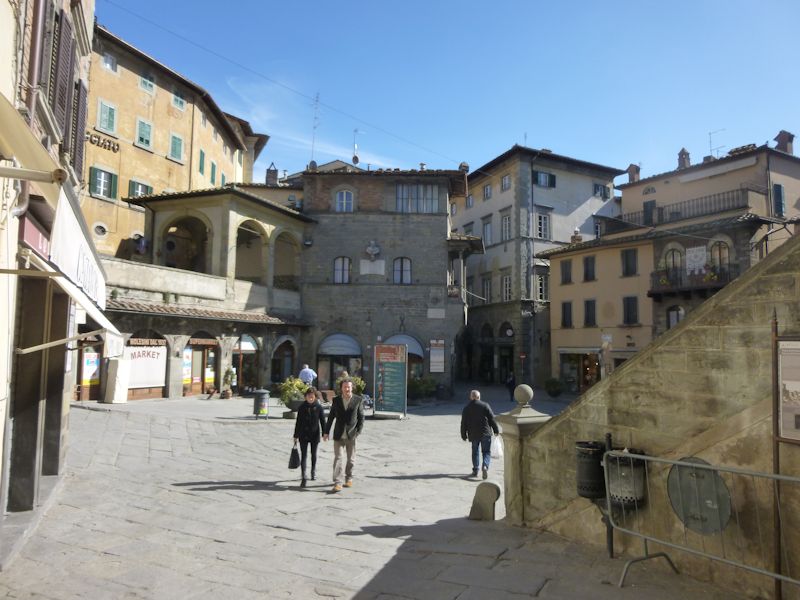
The Piazza della Repubblica . . .
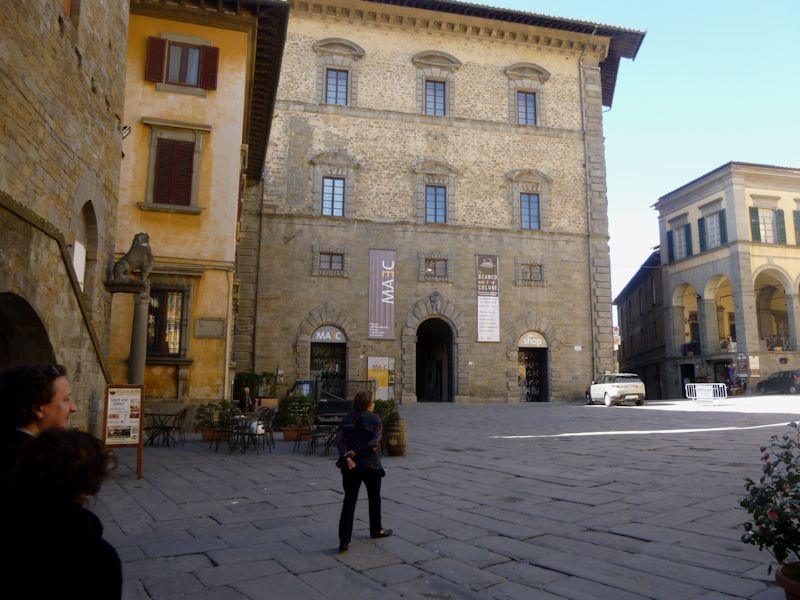
. . . leading into the Piazza Luca Signorelli (named after the Cortonese painter) and the Museo dell'Accademia Etrusca of Cortona, or MAEC [with, for some reason, a backward E] in the Palazzo Casali, once the home of the Casali family, Signori of Cortona from 1325 to 1409, but vastly renovated and expanded by the Florentine administration in the 17th century.
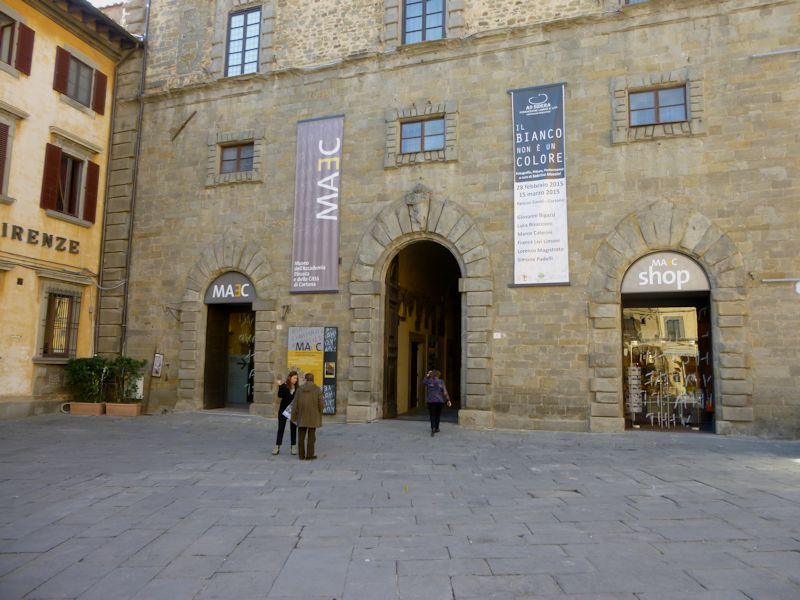
There's said to be a monthly antiques and bric-a-brac market in this square, but not today.
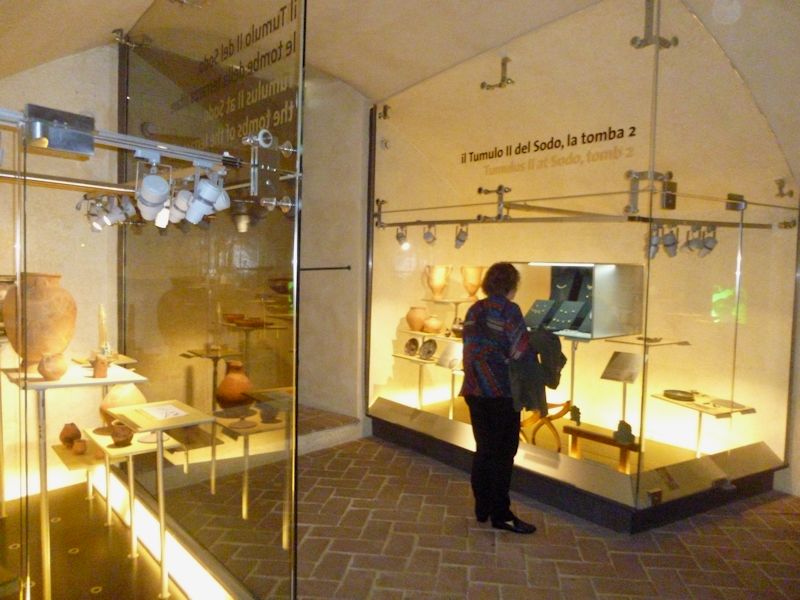
The region around Cortona abounds in Etruscan sites and artefacts and the MAEC museum displays them brilliantly; and, as it's also the home of the scholarly Accademia Etrusca, founded in 1727, its exhibits are authoritative.

Etruscan things, mostly from the 8th to the 5th centuries BC
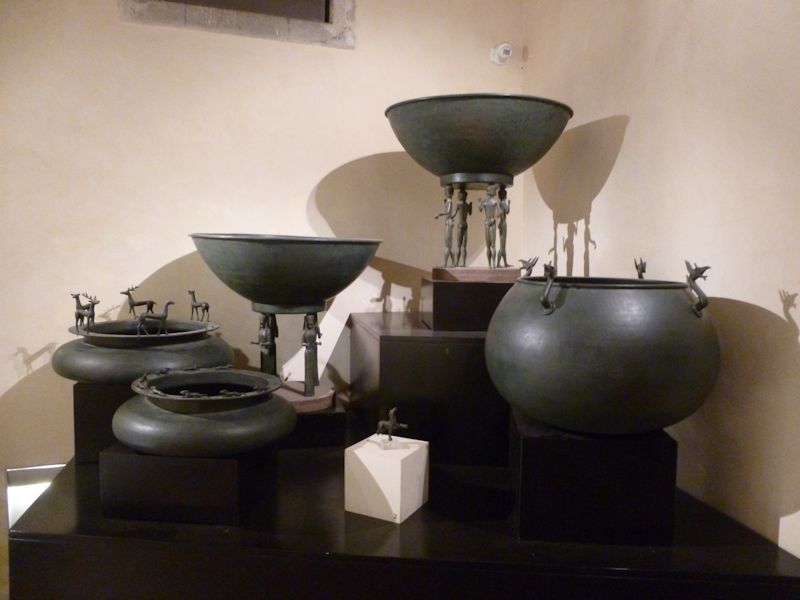
Religious items. The ample interpretative panels are concerned to show the evolution, in weapons, farm implements, household items, and religious and funeral artefacts, of early styles into later ones under the influence of the Hellenistic cities to the south.
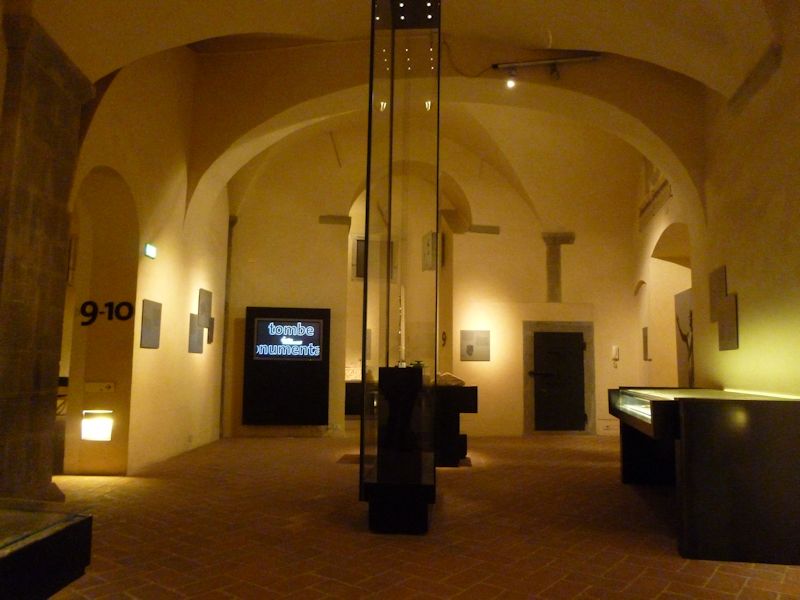
A brilliant melding of the old building, even with bits of Etruscan basement walls poking out from time to time, with modern educational technology

That's a cutaway of a special urn for breeding and fattening dormice ('sleepers', or hibernators), a Roman delicacy with honey and poppy seeds.
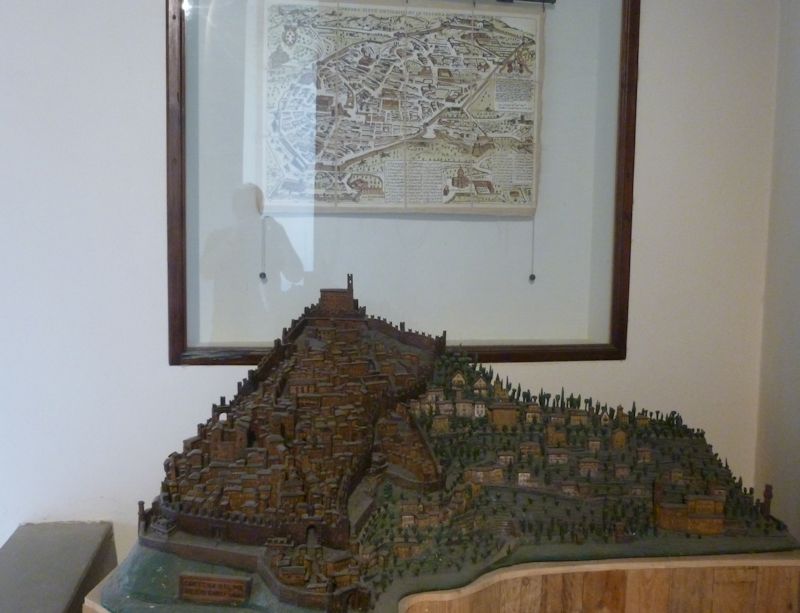
A maquette of medieval Cortona. The MAEC, in addition to being a hotspot for Etruscan lore, is also the City Museum.

The Virgin praying (13th century)

A table centrepiece for festive parties? Actually, an Etruscan chandelier, 4th century BC.
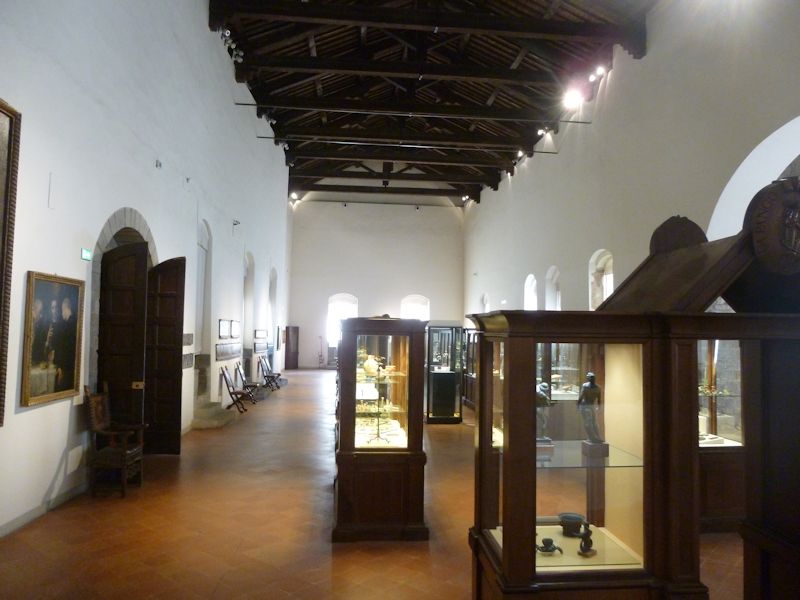
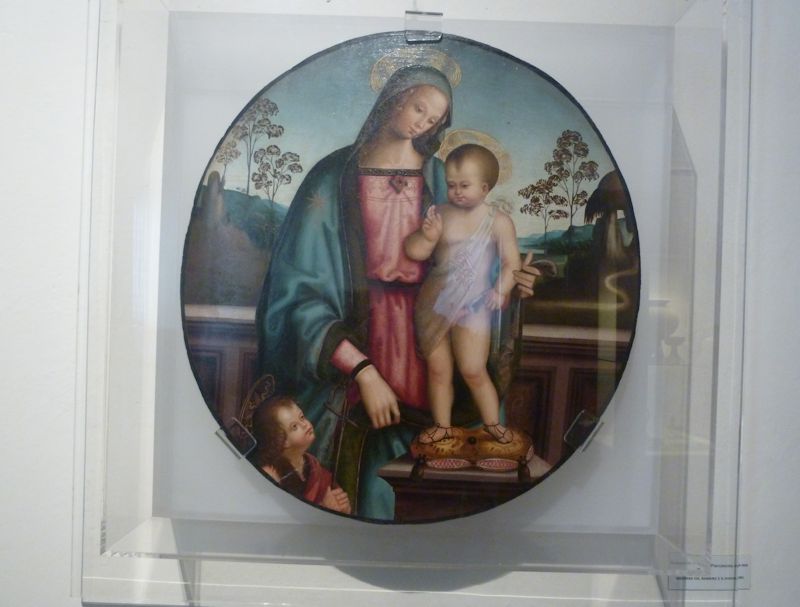
A tondo of the Madonna and Baby with Buzz-cut, and Little St John, by Pinturicchio (who was best known for helping with the Vatican Library)
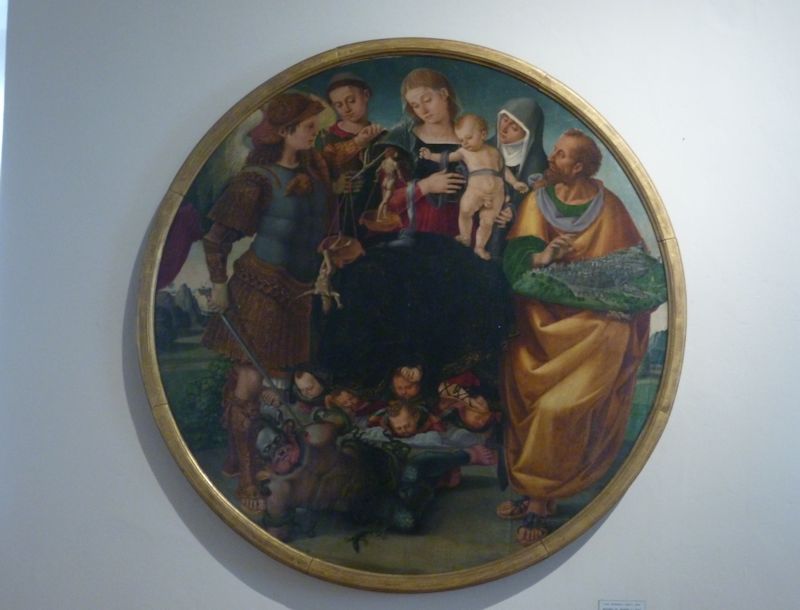
Finally, something actually by the local Favorite Son, Luca Signorelli (a.k.a. Luca da Cortona): The Madonna Standing on Babies' Heads, a.k.a. 'Madonna with baby and the protector saints of Cortona'

Jesus reading his mom to sleep

An Etruscan Academy meeting room

A thought-provoking knick-knack for the parlor (a funerary something-or-other)
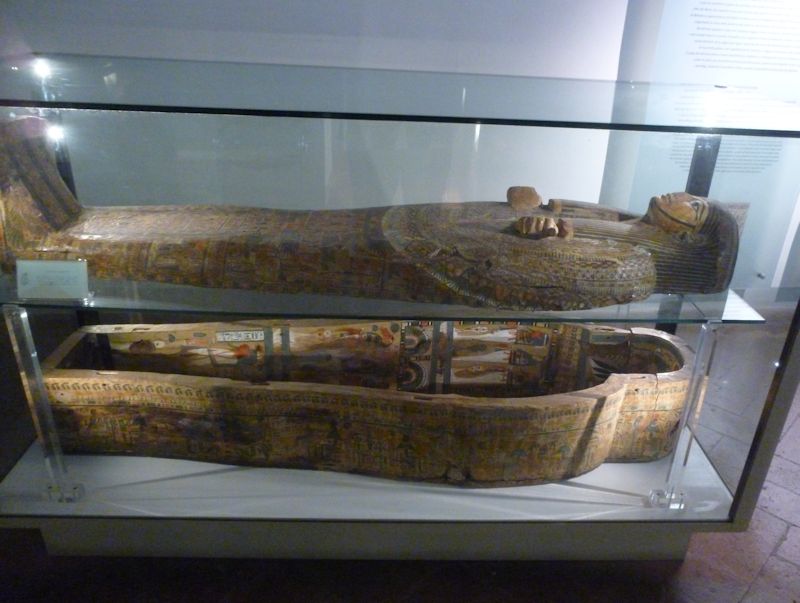
It's not all Etruscan or Cortonese; some early Cortona traveler came home with this.
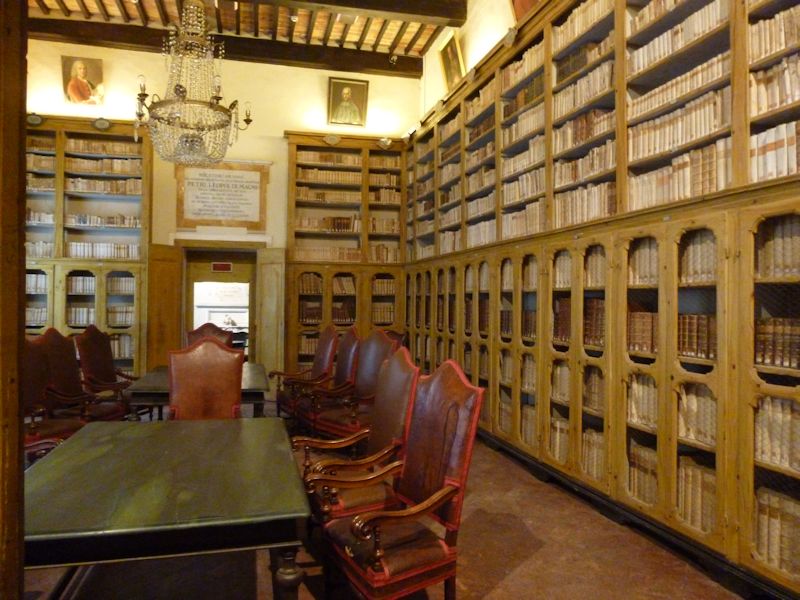
The library of the Accademia Etrusca and town historical archives

Nearby in the Palazzo Casali, the tourist office, closing for the day exactly NOW! Sorry, folks.
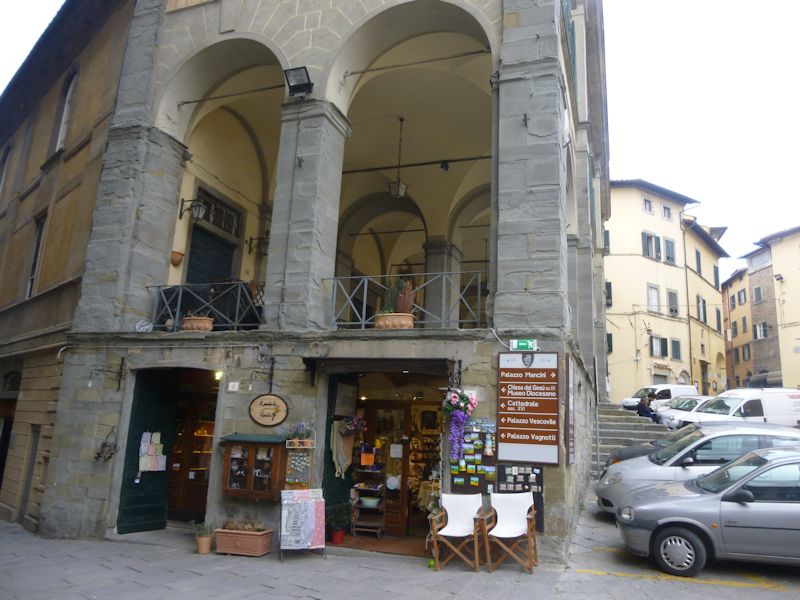
We're passing by the side of the Neoclassical Teatro Signorelli (designed in 1854) in the Piazza of the same name, on the lookout for a cathedral or whatever's passing for one here.

American college students relaxing in Cortona

Street scene

Just down the road into the Piazza Duomo
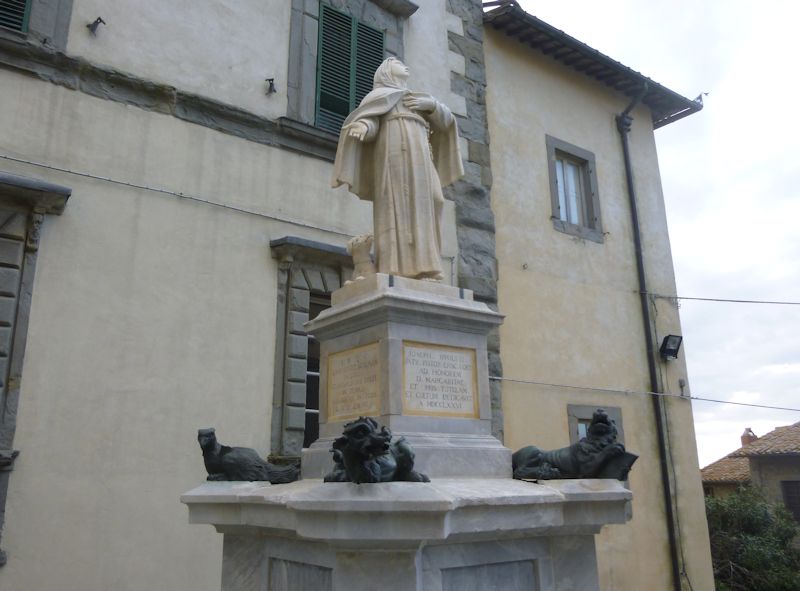
This appears to be a 1776 statue commemorating St Margaret of Cortona, a luckless fallen woman who was taken in with her son by the Franciscans (who kept the kid), 'pursued a life of prayer', and established the order of Our Lady of Mercy to help the sick and poor. (The lady herself, who died in 1297, presently resides in a church with her name on it way up the hill, still within the city walls, just below the Fortress of Girifalco.)

St Margaret's personal bodyguard

Next: the Co-Cathedral of Santa Maria Assunta in Cortona
        
      

 Feedback
and suggestions are welcome if positive, resented if negative, Feedback
and suggestions are welcome if positive, resented if negative,  .
All rights reserved, all wrongs avenged. Posted 26 April 2015. .
All rights reserved, all wrongs avenged. Posted 26 April 2015.
|
 Dwight Peck's personal website
Dwight Peck's personal website

















































































